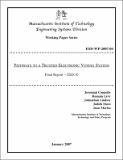| dc.description.abstract | In 2002, Congress passed the Help America Vote Act (HAVA) [1], largely in response to voting irregularities in the 2000 presidential election in Florida. Congress intended that HAVA resolve the lingering public confidence issues arising from inconsistent local election administration procedures, punch card voting machines, and voter registration. With HAVA, Congress authorized payments to the states to implement significant reforms of the voting system. However, the use of electronic voting machines to meet HAVA requirements threatens to damage public confidence in the voting system.
Several reports have been published that note security flaws in voting systems in use all over the country [2]. California sued a manufacturer claiming that the company had
misrepresented the security of its voting machines and falsified certification information [3]. In Ohio, a battleground state, recount irregularities also resulted in a lawsuit [4]. The public outcry and enormous media attention on these problems prompted Congress's Government Accountability Office (GAO) to launch an investigation [5]. | en_US |
